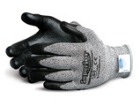
Understanding Cut Resistance Levels
The most important part of choosing a cut-resistant glove is determining the level you need. The two reigning systems are ASTM and EN-388 (also known as CE cut level). These different performance standards are not identical and do not correlate, which can potentially cause confusion when going through the selection process for choosing the right glove for specific applications. Understanding that there is a difference is step one. Understanding what those differences are is step two. It is important to keep in mind that ASTM results are more indicative of real-world use and application. Superior Glove Works has created a wonderful infographic that helps to lay out the different ASTM cut resistance levels in an easy-to-digest format.
Not sure what level of cut resistance to choose? There are many factors to consider: industry, application, and method of use. One way to determine the cut resistance level your job requires is to examine the gloves you (or your workers) are currently using. Are they satisfying user needs? Are they providing adequate protection? Assessing the gloves is often a good way to start. Next, get your gloves tested using an approved performance measure (such as the ASTM test method). Once you know the level of your current gloves and assess their performance for your job duties, you can determine whether you should try cut-resistant gloves rated at a higher level than your current ones. Next, trial a test glove of the desired level and assess performance of the same job duties, using the higher-rated glove.
Another way to determine the cut resistance level you require is to determine the best hand protection practices for your industry and adopt them. The Superior Glove Works Cut Resistance Infographic serves as a reference guide when comparing cut resistance levels.
Once you’ve chosen the required level of cut resistance, you should select a suitable style. Cut-resistant gloves come in a few different styles: gloves with leather palms, leather gloves with cut-resistant liners, palm-coated gloves, or string knits. Leather (or leather-palmed) cut-resistant gloves are commonly used in industries such as metal handling where good grip and abrasion resistance are important. Palm-coated and string knit styles are commonly used in industries where good dexterity is necessary, such as construction, automotive, and aerospace.
When it comes to selecting cut-resistant gloves, the level is imperative, but so is a proper fit. Fit is incredibly important because a good fit ensures comfort and safe function.
Posted by Joe Geng on Feb 20, 2013